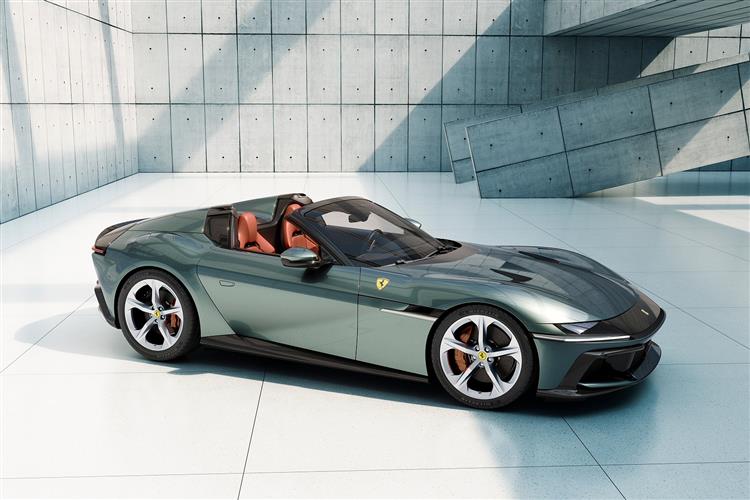SPIDER'S BITE (some text hidden) --NONE--
By Jonathan Crouch
In Spider form, Ferrari's 12Cilindri is an even more desirable V12 GT. Jonathan Crouch takes a look.
Ten Second Reviewword count: 28
Is Ferrari's 12Cilindri Spider Maranello's ultimate open top? You might well think so, provided you like the effect the metal folding roof has on this car's arresting looks.
Backgroundword count: 86
Inspired by legendary Grand Tourers of the '50s and '60s, Ferraris 12Cilindri Spider is one of two supercars that vie for the title of the ultimate V12-engined convertible. The other is Aston Martin's Vanquish Volante, which differs from its Maranello rival in its use of a fabric roof. Ferrari decided on a metal folding top for this convertible 12Cilindri in a bid to maintain more elements of the coupe version's futuristic silhouette. Creating a desirable variant that's expected to account for half of all 12Cilindri sales.
Engines and Tech Specword count: 344
You might fear the weight penalty that could come with adding a folding metal panel roof mechanism to a car like this, but actually this Spider variant weighs only 60kg more than the coupe version (which tips the scales at 1,560kg). That's despite the extra reinforcement needed around the A and B-pillars and the thicker sills. The roof folds in 14s at speeds of up to 28mph. Performance from the 6.5-litre naturally aspirated V12 is hardly any different from the coupe, 0-62mph demolished in 3.0s en route to 211mph. Aware that away from the track, there'll be hardly any opportunity for an owner to drive like this, Ferrari has modified the torque output in 3rd and 4th gears between 2,000 and 5,000rpm so the car can feel more responsive in the kind of press-on driving you'll be engaging in most. A clever 'Aspirated Torque Shaping' feature helps here too. Lots of careful engineering also aids performance; like the lightning responses of the paddleshift dual clutch transmission, which has eight ratios (replacing the old 812 model's seven-speeder). As does the way the lightweight aluminium chassis is particularly stiff around the suspension towers and the A and B-pillars. The big 6.5-litre engine has been tucked so far back under the enormous bonnet that it's behind the front axle line, so that weight distribution can be biased 52% towards the rear. The sheer size of that bonnet will take some getting used to when manoeuvring or on narrower roads. There are lots of tech tricks too, to make the car feel more agile than its size suggests it should be. Like 'Virtual Short Wheelbase 3.0' and 'Side Slip Control 8.0', made possible by 6D yaw rate sensors which better aid rotation out of corners. There's also the expected electronically controlled limited slip differential, along with active rear steering, variable stability control, slip control and a by-wire braking system. Magnetorheological adaptive dampers are controlled by Ferrari's usual mannetino dial and as usual with the brand, they can be configured with a useful 'Bumpy road' setting for secondary routes.
To see the full road test text contact us on 0330 0020 227
Pictures (high res disabled)

.jpg)
|
.jpg)
|
.jpg)
| |||
.jpg)
|
.jpg)
|
.jpg)
| |||
.jpg)
|

|
Statistics (subset of data only)
Min |
Max |
|
Price: |
£366,500.00 (At 9 May 2025) |
|
Insurance group 1-50: |
50 |
|
CO2 (g/km): |
360 |
|
Max Speed (mph): |
211 |
|
0-62 mph (s): |
3 |
|
Combined Mpg: |
17.8 |
|
Boot Capacity (l): |
200 |
|



